Off-the-grid camping trip 2017
Originally written October 19, 2017, edited May 19, 2019
The last camping trip by car, with tent, was several years ago.
Have got the itch again. My "traveling light" series will also
encompass the meaning of "light" as being independent,
self-sufficient, with a minimal collection of gear. Not walking
this time, so can throw a lot more into the car.
I moved house a couple of times since then, and some of the gear has gone astray. On the last trip, I stayed at some low-cost and free sites, without mains power. To handle this, I had a folding solar panel and a deep-cycle battery. I still have the panel, but not the battery.
That battery was 110AH, and was very heavy. Too heavy for me. At the time, it was on-sale at a very attractive price, and I reasoned that having more storage capacity was a "good thing".
Then there's the solar panel, it weighs 13kg. Not too heavy to
move around to keep facing the sun and avoid shadows, but at that
time I was having back pain issues, and found even simple chores
like that to be a challenge.
Now we are at October 2017, and shopping for new, lighter-weight, solar power gear...
Waeco CoolPower 44
Instead of buying a battery and then build a box with sockets, etc., decided to go for something ready-made, even though it cost a bit more. I purchased this battery-pack, Waeco CoolPower 44, rated at 44AH. It was on sale at Tentworld here in Perth, Western Australia, for AU$299.99:
https://www.tentworld.com.au/buy-sale/dometic-waeco-coolpower-raps-44ah-battery-pack
It is quite heavy, 13.5kg, but my back is better these days. Besides, I won't be moving it around much, plan to leave it in the car and run leads out. Here is a photo:
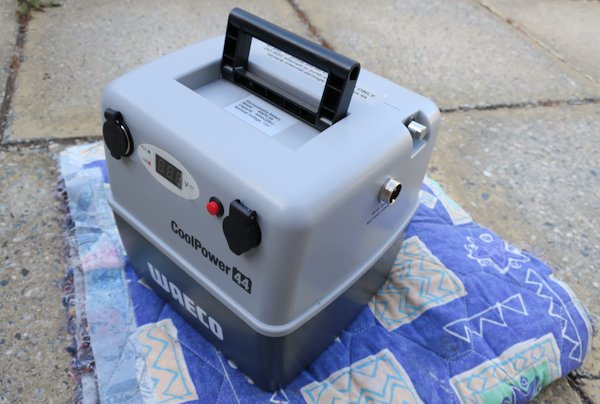
Notice the terminal lug, there is one on each side. This is the recommended way to connect a charger, with crocodile-clips, whether it be a mains-charger or solar panel.
There are also two threaded-sockets, one on each side, different sizes. A cable is provided to fit the smaller socket, with a cigarette-lighter plug on the other end -- so the battery can be charged while driving the car.
What attracted my attention is the large socket on the other
side. It is for connecting two CoolPower 44's together, and Waeco
sell a connecting cable for that purpose. But I immediately
thought of another use for it...
For the solar charging, the technology has marched on, and light-weight semi-flexible panels have improved in efficiency and cost has dropped. So, I went shopping again...
100W flexible solar panel
My local Jaycar store has an 80W flexible panel, asking price AU$269:
https://www.jaycar.com.au/80w-12v-semi-flexible-solar-panel/p/ZM9153
The peak-power-point output voltage is stated to be 15.4V. There is also a 100W panel, which has an extra row of cells, and this has a peak-power-point voltage of 17.8V. Ooo, more power... however, what most buyers don't realise is that they probably won't get any more power out of the 100W panel, than the 80W panel. Just bumping the output voltage does nothing, as input to the battery will be down around 14V, forcing the panel to output at that voltage (plus voltage drop in the charge-controller).
Thus, the 100W panel is a marketing gimmick. Ha ha, but I ended up buying a 100W panel, coz it was only AU$179.99, from here:
https://www.camping4wd.com.au/collections/power/products/100w-flexible-solar-panel
...a lot of blurb on that site about good-brand, 25-year guarantee, however, there is no manufacturer on the packaging. Also, when I bought it, the chap asked me if I want a receipt! Hmmm...
Anyway, a photo:

Fantastic, it only weighs 2.2kg! I also bought a charge controller, for AU$35. Now to connect them together...
Wiring solar panel to battery
The recommended method is to use crocodile clips, however, I had my eye on that large threaded-socket. The problem is, could not determine exactly what manufacturer/part-number it is. It looks like what is known as an "aviation socket". So, I just bought the Waeco cable kit for connecting two CoolPower 44's together, and cut the cable in half.
Here is a photo of the plug:
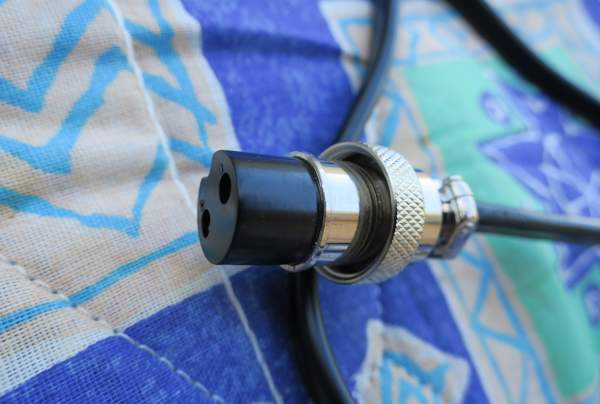
...can you identify this type of plug? My solution, to buy the kit, was expensive, however, those plugs look like top-quality, so would probably be expensive to buy individually, and having two of them could be useful. Plus, the kit came with a mounting frame, which I could adapt into a centralised electrical-control-box.
UPDATE:
I have had feedback from a couple of guys, that it is indeed an aviation plug. Thanks guys! These are available on eBay, type "GX16-2". For example: 1 2
Those rated at 20A look right. There are others with a lower current rating.
Tests with my multimeter showed that the small threaded socket has some electrical circuitry between it and the battery, probably for charge limiting and protection. The large threaded-socket, though, is connected directly to the battery.
Which is good, but also a worry. I decided to be very cautious, and inserted an in-line fuse between the threaded-plug and the solar charge-controller. Photo:

The in-line fuse holder and fuse I got from Jaycar:
https://www.jaycar.com.au/30a-blade-fuse-holder-with-screw-terminals/p/SZ2044
I purchased 10 metres of 2-core cable from Bunnings, to wire the solar panel to the charge-controller. Even 10 metres is minimal, as from past experience, I have parked in the shade, with the panel some distance away to catch the sun. The cable is intended for low-voltage outdoor lighting, and I bought the heaviest gauge, 2.5mm.
My old folding panel has the charge-controller affixed to the back of the panel, which I don't think is very good, due to voltage loss in the cable, especially in my case. Now that's a thought, I haven't measured the resistance of the cable... my trusty digital multimeter has been with me since the 1970s, and the most sensitive scale is 200 ohms. So, measurement is very inaccurate, but is in the ball-park of 0.1 ohms. Which means a voltage drop of about half a volt.
Considering that the panel puts out a ridiculously high 17.5V at
peak-power-point, there is plenty of volts to play with, so could
have used lighter-gauge cable, and/or longer. Especially as my
charge-controller is right at the battery, so it will work
accurately.
Well, the time has come to get out into the field and test this setup! It will be interesting to find out just how much power I do get out of this panel. The Chinese manufacturers in particular, are prone to exaggeration.
Lake Indoon
I camped for a few days at Lake Indoon, a free camping site a few hours drive north of Perth:
http://www.carnamah.wa.gov.au/visitors/lake-indoon
very pleasant spot, nice shady trees, lovely trails for walks.
Lots of birds here, as it is, as the name says, a lake.
Freshwater, brackish, not recommended for swimming. I took photos
of course. Photo of my car and tent:
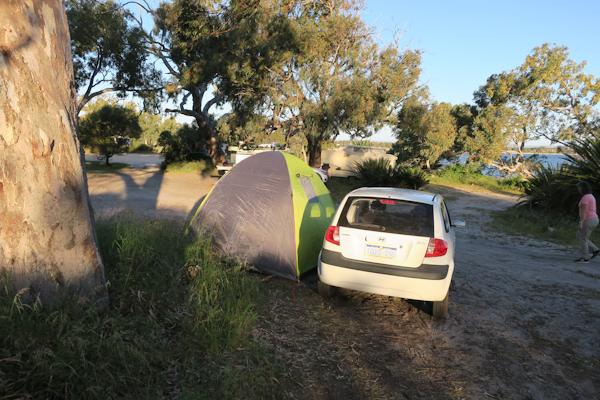
The facilities are good. Toilet block, with showers, rainwater tank. Shaded seating and barbecue:
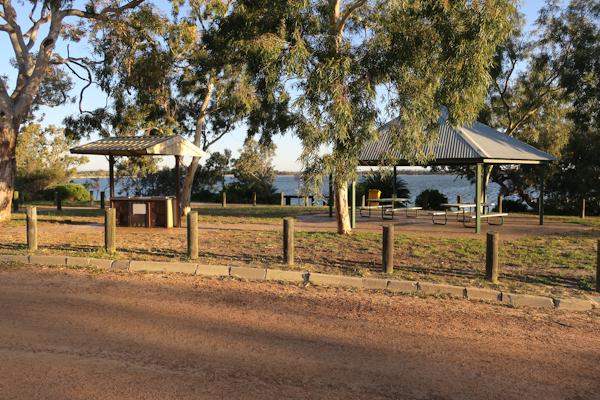
I took along various computer gear. This photo shows my trusty old workhorse laptop, 4TB external drive, 150W inverter to power the drive. Incoming cable from the battery has an adapter with two cigarette-lighter sockets and two USB sockets:
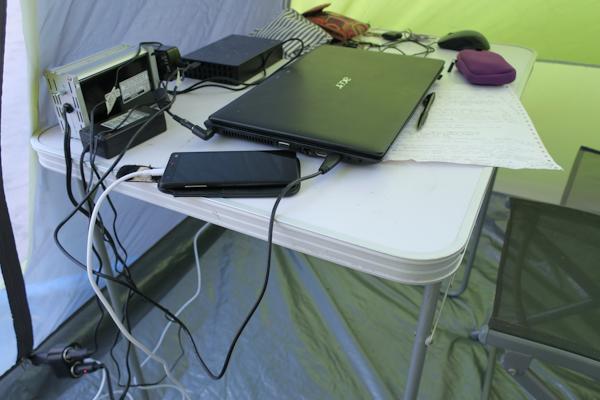
I took my old laptop, as it has a power adapter that runs direct from the 12V battery. I purchased that power adapter several years ago, prior to the last camping trip. Got it off the Internet, a site that specializes in adapters for running laptops from 12V. There is probably a link in one of my archived blogs. As I recall, it was an Aussie site.
It is quite pleasant being setup in the tent with all required computer gear. AND, there was an Optus 3G signal, so I had Internet access via my phone -- that was a pleasant surprise, as regional areas in Australia are generally better served by Telstra.
The weather was pleasant also, not too hot, clear sunny sky to test the panel. Ah, that panel. Not sure about it. Even after running the fridge for awhile to deplete the battery, was only getting about 2A out of the panel.
Now that I am back in Perth, intend to put resistive loads on the panel, find out definitely what power I can get out of it. So, expect more to be added to this post...
EDIT 2019-05-19:
Pretty obvious that something was not right with that 2 ampere reading
from the solar panel! The panel stayed in my garage, until two years
later, yesterday, I pulled it out and performed a much more precise
test, alongside two other panels for comparison:
http://bkhome.org/news/201905/measurements-for-three-solar-panels.html
...much better!
Tags: light
